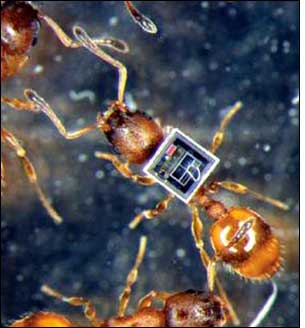Aug 01, 2009While businesses harness more computing power to analyze data and improve decision-making, biologists note that animals with simple brains and limited information make complex decisions in the real world. A group of researchers at the University of Bristol's School of Biological Sciences in the United Kingdom has employed RFID to study Temnothorax albipennis, a common ant, to understand how ants decide as a colony where to nest.
"The thing about ants is the individual behaviors add up to make a collective decision," says Elva Robinson, leader of the research. "We need to identify each individual ant, and we're able to do that by using radio tags and putting readers over the entrances of the nests."
This species of ant nests in cracks in stones, and colonies often have to move because the stones break open and are no longer suitable homes. To learn how these ants decide which of several nests to move to, the researchers set up colonies and a variety of nests in their lab, and have been tracking their movements.
Initially, they painted each ant a different color and filmed their activity, then manually recorded movements by viewing the film. That was slow and labor-intensive. Someone hit on the idea of using RFID to track the ants, but finding a tag small enough wasn't easy. After some digging, the team found a company called PharmaSeq that has developed a transponder just 500 microns square.
The researchers glue a transponder to an ant's thorax, the middle section of the body, so it's right over the ant's center of gravity. "Initially, they try to knock the transponder off," says Robinson, "but after a few hours, they get used to it and go about their normal behavior."
The transponders have a short read range—about 3 millimeters, or 0.1 inch—and they need to be oriented to the reader to capture the energy from the lasers. Researchers weren't able to read transponders on ants that entered or left the colony by walking upside down, so they redesigned the entrances of nests to force the ants to walk right side up.
The researchers set up obstacles for the ants and tracked them as they chose between, say, a poor-quality nest nearby or a better-quality nest farther away. After many trials, the researchers determined that ants don't compare the relative merits of one nest against another. "If they enter a poor nest, they carry on searching," Robinson says. "If they find a good nest, they return to the colony and bring others to the new nest. If they get enough ants to the new nest, the entire colony moves."
The ants don't seem to look for the perfect nest or even the better nest. They simply choose an adequate one. "It's interesting to see how ants solve problems with such simple rules," Robinson says. "We tend to emphasize multiple comparisons and complex analysis, when often a simple rule gets the desired result."
The ants could provide a new model for computers and artificial intelligence based on simple rules. Of course, humans will have to do a lot of complex analysis to see if we want to adopt this concept.
Photo: Professor Nigel Franks, University of Bristol

